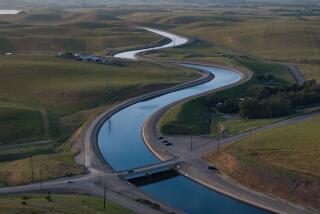Farms’ 33-Billion-Gallon Dilemma : Reclamation: Water drainage and levee repair are priorities along with efforts to salvage acreage for next year’s crops.
WEVER, Iowa — Three mornings a week, the Green Bay Levee District Commission convenes in a cramped firehouse to discuss an agenda that never varies: how to dispose of 33 billion gallons of Mississippi River floodwater.
More than 13,500 acres of land around Wever are submerged, and the displaced landowners who once farmed those sunken acres are impatient to get their property back.
“We’re not talking about this year’s crop,” said Harry Mabeus, a corn farmer desperate to reclaim 500 acres from the Mississippi. “We’re talking about next year’s crop.”
In Wever and in levee districts all along the Mississippi, flooded communities have begun to grapple with the disposal of the floodwater that imprisons their land.
“This is the hard part,” said William Klingner, a civil engineer who heads the Upper Mississippi Valley Flood Control Assn., an organization of 25 levee districts stretching from northern Iowa to southern Illinois. “We know from past floods what to expect. But we’ve never had to get rid of so much water.”
Hydrologists warn that ground water tables may not recede until next year in some riverfront areas, further snarling rebuilding efforts.
“They will have to pump out the flood plains long after the river is gone, and even that won’t assure that they stay dry,” said Robert Ettema, acting director of the Institute of Hydraulic Research at the University of Iowa.
In Wisconsin and Minnesota, where the Mississippi and its tributaries have dropped to more manageable levels, officials are getting a clear sense of the difficulties posed by removing floodwater and repairing the damage it causes.
In Black River Falls, Wis., for example, officials were able to move quickly to drain the town of excess water. But once the flood was gone, they learned that they were still months away from rebuilding 90 homes damaged when the Black River overflowed.
Several residents returned to their waterlogged houses and began pumping water out of their basements--then learned to their horror that they were creating more damage, said Larry Larson, director of the Wisconsin Floodplains Program.
After several basements caved in, officials realized that the pressure from ground water seepage was pushing in walls as internal water was pumped out.
“Just imagine what will happen south of here,” Larson said. “They can pump out every inch of the flood and they still won’t be able to do anything with their houses until the water table falls.”
Water removal will be impossible in many flood-stricken communities along the Mississippi unless levees are repaired first. In the deepest flood plains, water can be pumped back into the river, but not until levee walls are strengthened enough to keep river water out.
Water drainage and levee repair is being handled on a priority basis by the U.S. Army Corps of Engineers--a pecking order that sometimes depends as much on political clout as it does on public need.
“Some levees are going to receive more attention than others,” said Capt. Michael Gladbach, an engineer who meets weekly with Green Bay levee officials. “We can’t service everyone at once--especially not after a flood of this magnitude.”
And for those that get their levees repaired, pumping water back into the river is still problematic.
Most of the giant pumps--capable of dispersing up to 200,000 gallons a minute--are now under water and idled. They will have to be dismantled, cleaned and reassembled--a process that can take weeks, according to Klingner.
Green Bay officials say they are desperate to get their pumps working. If the water is still there by the first winter freeze--expected in late November or early December--and debris from the flood remains trapped underneath, their chance of getting dry soil for next spring’s planting grows more remote.
Pumps are less critical in districts where floodwaters can run out naturally. Officials in the Fabius Drainage District in West Quincy, Mo., where a levee break shut down the Bayview Memorial Bridge and cut off a vital artery between Missouri and Illinois, say that as soon as the river drops below flood stage, they hope to begin draining operations.
The Fabius district may be among the more fortunate levee areas. The nearby bridge--which depends on the levee to protect the access road--makes the levee a prime candidate for urgent repair by the Army Corps of Engineers.
“I don’t think we’ll have to do the pushing,” Levee Commissioner Norman Haerr said. “The city fathers and highway officials here and in Quincy will yell loud enough to get this bridge back.”
Other districts are taking no chances. Green Bay levee officials have already pleaded with Iowa Gov. Terry E. Branstad and the state’s two senators, Tom Harkin and Charles E. Grassley, to persuade Army engineers to put their levee at the top of the repair list. And at the weekly meetings at the Wever firehouse, farmers have repeatedly grilled Gladbach to find out when they can expect government aid.
“They’re really leaning on us,” Gladbach said after one meeting. “They’re the best organized of any of them.”
Corps of Engineers officials from Washington and seven Midwestern districts met in Kansas City recently to start setting priorities. Although the Corps of Engineers declined to discuss the meeting, officials said that as a rule, levee districts containing towns, government buildings or major businesses stand a better chance of winning speedy repair orders than do agricultural levee districts.
More to Read
Sign up for Essential California
The most important California stories and recommendations in your inbox every morning.
You may occasionally receive promotional content from the Los Angeles Times.










